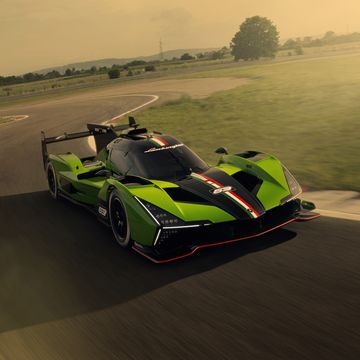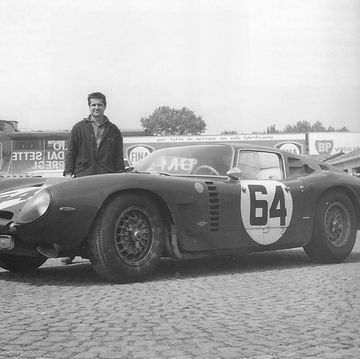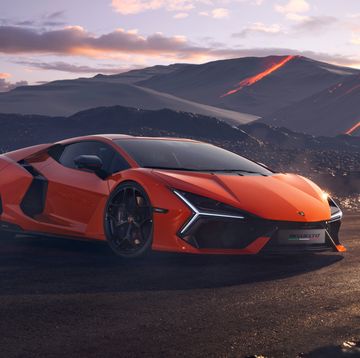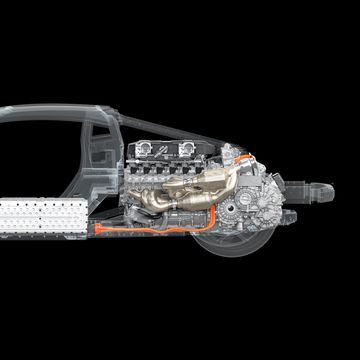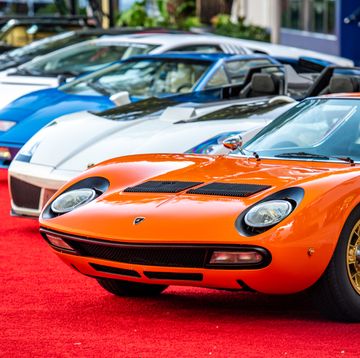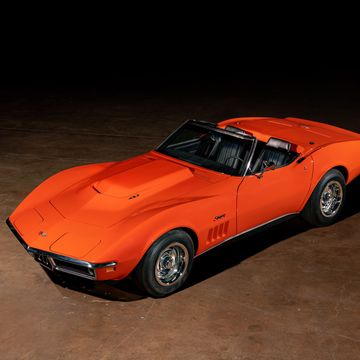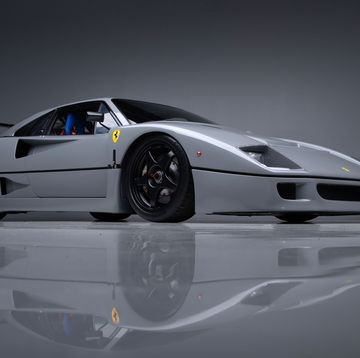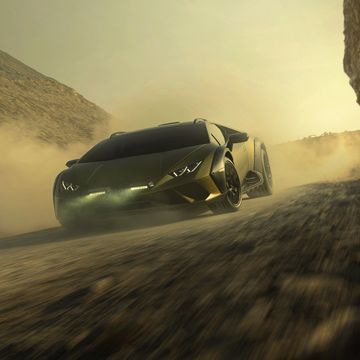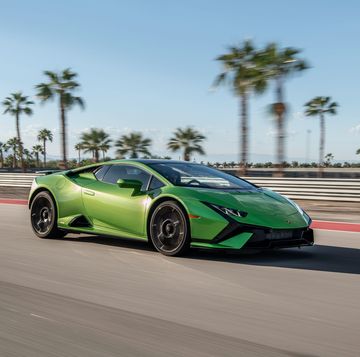- Lamborghini Huracan Sterrato takes the supercar where it has never been.
- 602 hp to all four wheels makes this a dirt-flingin' funster.
- Only 500 are slated for the US, at $273,177, with most already spoken for.
Heading straight off the pavement and into the desert dirt, your brain’s first inclination is to scream “NOOOO!” Somewhere in your noggin is a primitive instinct that says Lamborghini supercars are not supposed to go there. If they do, you have made a terrible mistake, and you are going to be digging pebbles out of your tire beads for days, or worse.
But no, this Lamborghini Huracan is actually supposed to go off track, into the dirt, and keep going, often sideways.
The Lamborghini Huracan Sterrato was officially created by a few guys on the Urus engineering team. They had just finished the Urus and were driving it around off-road on some of the few off-road-capable areas in Italy where you can drive and won’t get arrested, and they thought, “Why not do this same thing with something like—hey, how about that Huracan over there?”
Indeed, they took a Huracan Performante development car that was just lying around and transformed it into roughly what you see here: the fully off-road-capable Lamborghini Huracan Sterrato.
It had been done before, by Lamborghini and by others. Lamborghini’s own legendary engineer and test driver Bob Wallace created rally-style versions of the Urraco and Jarama in the 1970s. Lancia built the Stratos HF from 1973-1978, the greatest rally car ever made, bar none. Porsche made the 1984 911 Carrera 3.2 4x4 Dakar 953 that won the 5000-mile race that year and inspired the current Porsche Dakar. And Giugiaro created coupe and cabriolet versions of its magnificent, Lamborghini-V10-powered Parcour concepts at Geneva in 2013 (as well as the all-electric Kangaroo concept in 2019).
But none of that comes up in the official reading of the roots of the Sterrato. Officially, the engineers came up with the idea, and when the dashing Stephan Winkelmann made his triumphant return to Lamborghini in 2020, he immediately gave it the green light. We like Winkelmann.
The basis of the Sterrato is mostly Huracan Tecnica and/or STO, a great place to start. The Sterrato gets a 602-hp 413-lb-ft version of the Huracan’s V10 mounted longitudinally behind the seats and powering all four wheels. Now, maybe you think you’d have more fun with rear-wheel-drive only. Maybe you would, maybe you wouldn’t. In a minute I’ll tell you it was a ton of fun with AWD pushing and pulling the car around in the dirt.
That V10 is mated to a 7-speed dual-clutch transmission and electronically controlled all-wheel drive with rear mechanical self-locking differential “designed to offer optimum performance on loose surfaces.” On firm surfaces it’ll hit 62 mph in 3.4 seconds and will top out at a tire-limited 160 mph (some references say 162). Bridgestone made a bespoke tire for the Sterrato that would perform on both dirt and pavement at speeds at which most pure off-road tires would come flying apart.
Since there’s nowhere to stow a spare, the tires are run-flats. That adds some unsprung weight but not as much overall weight as it would if you had to carry around a spare tire on top of the deck lid. And the extra toughness of a run-flat in the dirt is appreciated. The Dueler All-Terrain AT002 combines big tread blocks with firm rubber to perform well in both environments. And don’t stop driving it in winter, either. Bridgestone makes a Sterrato-specific winter tire, too.
Another concession to off-road use is the big snorkel on the roof, slurping in air that has a much lower dirt content than it would if Lambo stuck with the side air intakes (which are blocked off on the Sterrato). Only problem is the snorkel blocks all vision out the back window. Why not install a rear-view camera, projected in the rear-view mirror? They had no good answer.
Optional equipment includes those two tacked-on light blocks on the nose and the minimalist roof racks, which don’t look ready to hold anything without some creative engineering. The wheel arch extensions are standard equipment.
Off we started, first on pavement. Like an idiot, upon exiting the hotel driveway I looked for the switch that raises the nose on Huracans and Aventadors to clear obstacles and rain gutters. Schmuck! The whole thing is raised 1.7 inches over stock, about as much as the nose-lift feature. It also has a slightly longer wheelbase as a result of jacking up the car.
Sterrato rides on springs that are 25% softer and travel 1.3 inches longer to accommodate the bumps and ruts it will find off-road. The only real-world pavement driving I had was on a long interstate, on 35-mph National Park roads, and around a couple of freeway ramps, the latter which I took in Sport mode at speed and on which the Sterrato felt perfectly grippy.
Sport mode sends up to 80% of torque to the rear wheels, which is always nice. I have heard others say they felt more body roll than a stock Huracan, but you have to really push it to feel that, and I was pushing fairly hard, enough to make my co-driver stop talking (briefly).
These seats are more adjustable than those in the last Huracans I drove—the STO and Tecnica, the seats of which were jammed against the rear of the cockpit. These seats allowed for a more comfortable position for my normal-ish 6-foot frame.
The track drive was at a facility called Chuckwalla, a place so far out in the desert that it’s named after a giant lizard. It’s worth the drive. Chuckwalla is among the more entertaining of Southern California’s race tracks, with some elevation changes and a nice, long, on-camber sweeper. Here the Sterrato didn’t feel like it wallowed at all, which would cancel out my earlier concern. I was pushing it fairly hard again, even with a dashing Italian race car driver riding shotgun and pointing out braking points via the helmet-mounted headset.
After a couple pavement turns there were two big white cones through which we were to drive straight onto the dirt.
The most impressive thing about this setup off-road is the way it remained rear-biased in torque and so easy to pitch the tail out. The Rally mode I’d switched to just before departing the pavement encourages tail happiness—to a point. I’m sure that without Rally mode’s remaining traction control I would have looped the car in some of this marvelous, deep dirt, but with it I felt like some Finnish guy with lots of vowels in his name. All 602 hp were trying their best to do whatever they thought I wanted the car to do.
At certain points, waves of dirt washed over the Sterrato—a phenomenon I hadn’t seen since racing in the Baja 2000 many years ago. The dirt portion of the track—scraped out inside the paved road course—was soft sand, so it had to be re-dragged every couple of runs to maintain some semblance of the rally tarmac in which this car does its best. In reality, the dirt was too deep in many stretches for the Sterrato to do well. Nonetheless it was a blast. At speeds far greater than I would have expected, the Sterrato remained composed, despite its sideways, dirt-flinging positioning.
Was it worth $273,177? Depends how you look at these things. While it’s true you could go to race-dezert.com’s classifieds and find something that would be this much fun in dirt for about $250k less, whatever that is would not be able to go 160 mph on a road course, at least without taking off.
The Sterrato offers a remarkable balance of dirt and asphalt and something truly, refreshingly different. There are only 500 being offered in the US, most of which have been spoken for. So speak up, for goodness’ sake. And if you do get one, go off road with it. They have car washes to take care of all that dirt. But nothing will wipe the loopy grin off your piehole.
Do supercars belong in the dirt? Please comment below.





